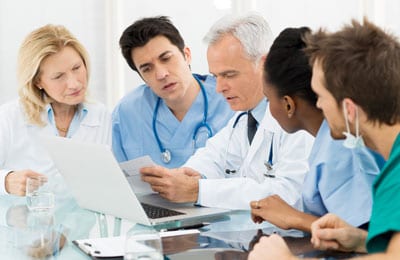Purpose
Learn more about how healthcare facilities, community agencies, and federal, tribal, state, and local agencies will coordinate activities and resources if there is ever an emergency caused by the release of B. pseudomallei bacteria.

Healthcare response activities
If there is ever an emergency caused by the release of B. pseudomallei bacteria, hospitals and other healthcare facilities will be called upon to diagnose, treat, and care for patients with melioidosis.
Epidemiological investigation
All melioidosis cases should be investigated to identify where, when, and how patients were exposed to B. pseudomallei, the bacteria that cause the disease.
People can be exposed to B. pseudomallei by:
- Breathing in contaminated dust or water droplets
- Having contact with contaminated soil or water, especially through ingestion or skin abrasions
Person-to-person transmission is very rare.
Some individuals who developed symptoms soon after coming into contact with B. pseudomallei, but before an emergency is identified, may be misdiagnosed. Healthcare facilities may need to work with public health authorities to review charts to identify and contact individuals who require further testing and treatment.
An epidemiologist or state or local health department official will need to interview identified patients, focusing on:
- Travel history to endemic areas, both during the person's lifetime and during the previous 21 days
- Places where the patient has been locally in the previous 21 days
- Any contact with imported animals or commercial products
- Anyone they have spent time with during the previous 21 days, especially those who have similar symptoms
Identifying other people with symptoms helps investigators find the source of exposure. Newly identified patients can also begin treatment.
Interviewers do not need to wear personal protective equipment (PPE) during these interviews.
Resource coordination
During a melioidosis emergency, state and local public health agencies should coordinate with healthcare facilities treating patients with melioidosis to ensure facilities have adequate supplies, such as ventilators.
The Strategic National Stockpile (SNS) works with governmental and nongovernmental partners to upgrade the ability to respond to a national public health emergency, ensuring that federal, state, and local agencies are ready to receive, stage, and distribute products.
State and local public health departments will need to communicate regularly with CDC and share information to determine where medicines and supplies are needed. State health departments will be responsible for coordinating with CDC to ensure any medical countermeasures released from SNS for post-exposure prophylaxis and/or treatment of melioidosis are distributed to local areas that need them.
In an emergency, hospitals communicate with their state public health department's Medical Countermeasures Coordinator to request additional supplies, such as ventilators, from the SNS.
Treatment and medical countermeasures
Currently, there are no FDA-approved therapeutic agents specifically for post-exposure prophylaxis or treatment of melioidosis. In a public health emergency, CDC will recommend and provide certain antimicrobials through emergency use authorization (EUA).
All patients with melioidosis will need to be treated with an appropriate antibiotic regimen. Treatment consists of:
- A round of intravenous antibiotics, which lasts 2 to 8 or more weeks, followed by
- A round of oral antibiotics, which lasts 3 to 6 or more months
Some patients may require intensive care, including ventilator support.
Infection control
Healthcare workers should follow standard precautions when caring for patients with melioidosis. Melioidosis is not considered to be transmitted person-to-person in the air or from respiratory droplets in non-laboratory settings. There have only been a few documented cases of person-to-person transmission; percutaneous inoculation (getting infected through a skin puncture) is probably the most frequent route for natural infection.
Disinfect and sterilize patient care equipment and environmental surfaces through regular infection control practices in areas where melioidosis patients are evaluated, admitted, and treated.
Enhanced surveillance and case reporting
Once an emergency has been announced, state and local public health authorities will need to classify cases as probable or confirmed using the case definition for melioidosis. Federal, state, and local preparedness efforts should plan to use enhanced surveillance and case reporting from health care providers to:
- Ensure rapid identification and reporting of additional cases after the initial case has been confirmed.
- Estimate the size of the at-risk population.
- Identify unexpected epidemiological features of the outbreak.
- Evaluate the characteristics and extent of the outbreak.
- Monitor effectiveness of response efforts in minimizing the spread of the disease.
Prepare for effective surveillance and case reporting during an emergency by:
- Educating medical and public health workers about melioidosis, its signs and symptoms, and its potential for use as a bioweapon.
- Developing or adapting information management systems to monitor calls and reports received.
- Designating a centralized location for reporting probable and confirmed melioidosis cases.
- Identifying and testing emergency notification systems and ensuring that on-call staff have appropriate access to communication resources, such as cell phones and laptops.
